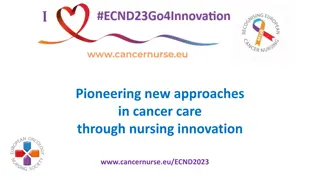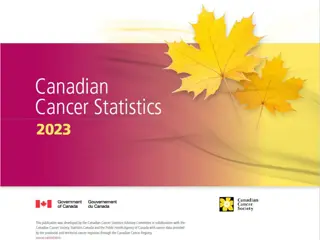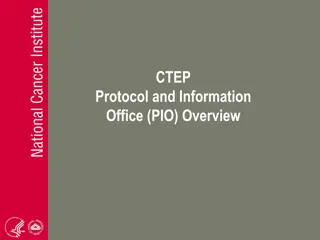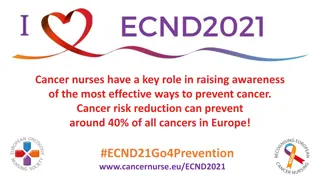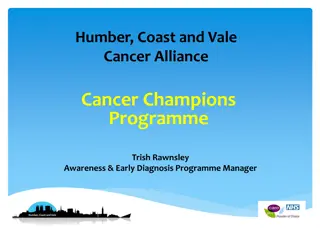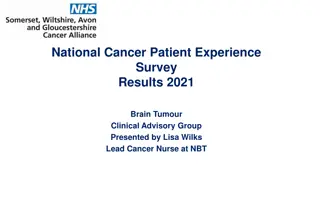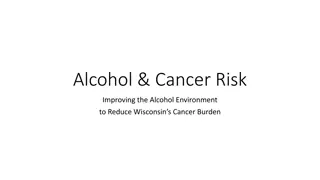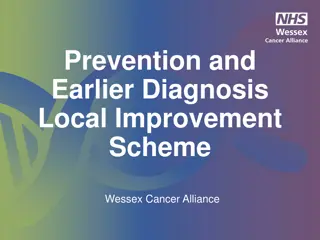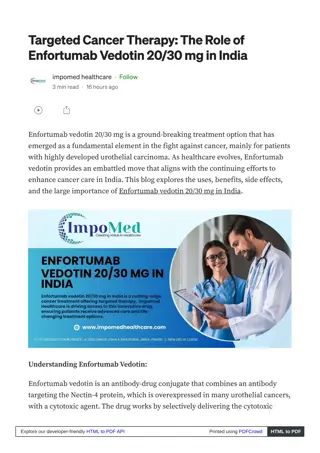
Update on Enfortumab Vedotin Plus Pembrolizumab for Urothelial Carcinoma
Explore the latest findings from the EV-103 study on the combination of enfortumab vedotin and pembrolizumab for locally advanced or metastatic urothelial carcinoma, providing insights into durability, progression-free survival, and overall survival in patients unable to receive cisplatin as first-line therapy.
Download Presentation

Please find below an Image/Link to download the presentation.
The content on the website is provided AS IS for your information and personal use only. It may not be sold, licensed, or shared on other websites without obtaining consent from the author. If you encounter any issues during the download, it is possible that the publisher has removed the file from their server.
You are allowed to download the files provided on this website for personal or commercial use, subject to the condition that they are used lawfully. All files are the property of their respective owners.
The content on the website is provided AS IS for your information and personal use only. It may not be sold, licensed, or shared on other websites without obtaining consent from the author.
E N D
Presentation Transcript
MEETING SUMMARY ASCO GU 2020, San Francisco, USA Assoc. Prof. Shilpa Gupta Cleveland Clinic, Ohio, USA UROTHELIAL CANCER UPDATE
DISCLAIMER Please note: The views expressed within this presentation are the personal opinions of the author. They do not necessarily represent the views of the author s academic institution or the rest of the GU CONNECT group. This content is supported by an Independent Educational Grant from Bayer. 3
STUDY EV-103: PRELIMINARY DURABILITY RESULTS OF ENFORTUMAB VEDOTIN PLUS PEMBROLIZUMAB FOR LOCALLY ADVANCED OR METASTATIC UROTHELIAL CARCINOMA Rosenberg JE, et al. ASCO GU 2020. Abstract #441 (Oral presentation) 4
INTRODUCTION Platinum chemotherapy is the standard of care for patients with metastatic Urothelial Carcinoma (UC) in the first line setting Gemcitabine/carboplatin is a standard therapy in patients who are cisplatin ineligible but it is poorly tolerated and associated with limited durability and survival. Enfortumab vedotin is an antibody-drug conjugate comprised of the nectin-4 antibody enfortumab coupled to the microtubule disrupting agent monomethyl auristatin E (MMAE). Nectin-4 is highly expressed in UC Results from EV-103 were presented at ESMO 2019. EV-103 evaluated enfortumab as a first-line agent in combination with pembrolizumab, and the results from the cisplatin- ineligible (cohort A) demonstrated a 62% objective response rate with 14% of patients achieving a complete response1 This presentation presents updated durability, progression-free survival and overall survival data for enfortumab vedotin and pembrolizumab in the first-line setting for patients who could not receive cisplatin as first line therapy for locally advanced or metastatic disease MMAE, monomethyl auristatin E; UC, urothelial carcinoma 1. Hoimes C, et al. Annals of Oncology (2019) 30 (suppl_5): v356-v402. 10.1093/annonc/mdz249; 2. Rosenberg JE, et al. ASCO GU 2020. Abstract #441 (Oral presentation) 5
EV-103 STUDY DESIGN EV-103 FIRST-LINE COHORTS OF ENFORTUMAB VEDOTIN PLUS PEMBROLIZUMAB Enfortumab vedotin 1.25 mg/kg + pembrolizumab (200 mg) in 1L cisplatin-ineligible la/mUC patients (N=45) Dosing: Enfortumab vedotin on days 1 and 8 and pembrolizumab on day 1 of every 3-week cycle Dose Dose Expansion Cohort A Patient Population Escalation1 Enfortumabvedotin exposure: Comparable to enfortumab vedotin monotherapy on 4-week schedule (Days 1, 8 and 15)2 enfortumab vedotin + pembrolizumab enfortumab vedotin + pembrolizumab Locally Advanced or Metastatic Urothelial Carcinoma cisplatin-ineligible cisplatin-ineligible Primary endpoints: safety and tolerability (n=5) (n=40) Key secondary endpoints: dose-limiting toxicities, ORR, DOR, PFS OS 1Not included in the current analysis: three 1L patients treated with EV 1 mg/kg + pembrolizumab 200 mg and two 2L patients treated with EV 1.25 mg/kg + pembrolizumab 200 mg 2Rossenberg et al. J Clin Oncol. 2019;37(29)2592-600. Data is presented on 45 patients, who have received a median of 9 cycles of therapy (range 1-22) 1L, first-line; 2L, second-line; DOR, duration of response; EV, enfortumab vedotin; mUC, metastatic urothelial carcinoma; ORR, objective response rate; OS, overall survival; PFS, progression-free survival 6 Rosenberg JE, et al. ASCO GU 2020. Abstract #441 (Oral presentation)
EV-103 BASELINE DATA Enfortumab vedotin 1.25 mg/kg + pembrolizumab in 1L setting 8 Oct 2019 data cut-off Patients (N=45) n (%) Male sex, n (%) Age, yrs, median (min, max) ECOG performance status, n (%) 0 1 2 Primary tumor location, n (%) Lower tract Upper tract Metastasis sites, n (%) Lymph nodes only Visceral disease Liver PD-L1 status by combined positive score,1n (%) <10 10 Not evaluable/not available 36 (80) 69 (51, 90) 16 (36) 23 (51) 6 (13) 31 (69) 14 (31) 4 (9) 41 (91) 15 (33) 19 (42) 14 (31) 12 (27) 1 Unselected patient population; PD-L1 tested using the 22C3 PharmDx assay from Agilent/Daklo The majority of patients were men with visceral disease Patients with low and high PD-L1 status were balanced 1L, first-line; ECOG, Eastern Cooperative Oncology Group;PD-L1, programmed ligand death-1 7 Rosenberg JE, et al. ASCO GU 2020. Abstract #441 (Oral presentation)
SAFETY AND TOLERABILITY TREATMENT-RELATED ADVERSE EVENTS (TRAE) TRAEs by preferred term 8 Oct 2019 data cut-off Patients (N=45) n (%) Any Grade 20% of patients 43 (96) 22 (49) 22 (49) 22 (49) 20 (44) 17 (38) 15 (33) 14 (31) 13 (29) 13 (29) 9 (20) 9 (20) 8 (18) Grade 3 10% of patients 26 (58) 4 (9) 2 (4) 3 (7) 0 4 (9) 0 1 (2) 3 (7) 0 8 (18) Overall Fatigue Alopecia Peripheral sensory neuropathy Diarrhea Decreased appetite Dysgeusia Rash maculo-popular Nausea Pruritus Anemia Weight decreased Lipase increased 7 patients (16%) had treatment related SAEs 1 patient (2%) died due to multiple organ failure SAE, serious adverse event; TRAE, treatment-related adverse event 8 Rosenberg JE, et al. ASCO GU 2020. Abstract #441 (Oral presentation)
OBJECTIVE RESPONSE RATE MAXIMAL TARGET LESION REDUCTION BY PD-L1 STATUS ORR PER INVESTIGATOR Tumour size (% change from baseline) PD-L1 Expression High (CPS 10) Low (CPS <10) Not evaluable Best Response Confirmed CR/PR 100 80 Confirmed ORR 95% CI 73.3% (33/45) (58.1, 85.4) 60 93% had tumour reduction Complete response 15.6% (7/45) 40 20 Partial response 57.8% (26/45) 0 Best Overall Response Per RECIST v 1.1 by investigator (N=45) -20 -40 -60 -80 -100 Individual patients (n=43) Responses observed regardless of PD-L1 expression level Two patients did not have post-baseline response assessments before end-of-treatment: 1 withdrew consent and 1 died before any post-baseline response assessment. These patients are included in the full analysis set used to calculate ORR, but are not included in the figure above. Horizonal lines at positive 20% and negative 30% denote thresholds for target lesions for disease progression and response, respectively. Median follow-up of 11.5 months Confirmed investigator-assessed ORR of 73.3% (95% CI: 58.1-85.4) Includes 15.6% CR and 93.3% DCR CI, confidence interval; CPS, combined positive score; CR, complete response; DCR, disease control rate; ORR, objective response rate; PD-L1. Programmed death-ligand 1; PR, partial response; RECIST, Response evaluation criteria in solid tumors 9 Rosenberg JE, et al. ASCO GU 2020. Abstract #441 (Oral presentation)
DURATION OF RESPONSE ENFORTUMAB VEDOTIN + PEMBROLIZUMAB Median follow up of 10.4 months Median DOR not been reached (range: 1.2-12.9+ months) Of the 33 responders: 18 (55%) had an ongoing response 11 (33%) had progressed or died 4 (12%) started new treatment prior to PD CI, confidence interval; DOR, duration of response; PD, progressive disease 10 Rosenberg JE, et al. ASCO GU 2020. Abstract #441 (Oral presentation)
SURVIVAL DATA ENFORTUMAB VEDOTIN + PEMBROLIZUMAB Overall survival Progression-free survival CI, confidence interval; OS, overall survival; PFS, progression-free survival 11 Rosenberg JE, et al. ASCO GU 2020. Abstract #441 (Oral presentation)
CONCLUSIONS In first-line cisplatin-ineligible patients, combination therapy with enfortumab vedotin and pembrolizumab shows promising activity and durability A high overall response rate was observed, with 88% of patients having responded at first assessment and responses being evident within 2 months (median) of treatment Combination therapy was associated with a manageable safety profile and no new safety concerns were identified Further evaluation of the enfortumab vedotin and pembrolizumab combination in metastatic UC and muscle-invasive UC is ongoing UC, urothelial carcinoma 12 Rosenberg JE, et al. ASCO GU 2020. Abstract #441 (Oral presentation)
PHASE II RANDOMIZED PLACEBO-CONTROLLED NEOADJUVANT TRIAL OF NINTEDANIB OR PLACEBO WITH GEMCITABINE AND CISPLATIN IN LOCALLY ADVANCED MUSCLE INVASIVE BLADDER CANCER (NEO-BLADE) Hussain SA, et al. ASCO GU 2020. Abstract #438 (Oral presentation) 13
INTRODUCTION Neo-adjuvant chemotherapy (gemcitabine and cisplatin) improves overall survival in patients with MIBC Nintedanib is a small molecule tyrosine-kinase inhibitor, targeting vascular endothelial growth factor receptor-2, fibroblast growth factor receptor-1 and platelet derived growth factor receptor The NEO-BLADE study, investigates the toxicity and efficacy effects of adding nintedanib to the usual neo-adjuvant chemotherapy combination of gemcitabine and cisplatin in patients with MIBC MIBC, muscle invasive bladder cancer 14 Hussain SA, et al. ASCO GU 2020. Abstract #438 (Oral presentation)
STUDY DESIGN Randomised, placebo controlled, phase 2 study 120 patients with MITCC, T2-T4 N0M0, GFR >60ml/min Arm 1: 12 weeks Gemcitabine, Cisplatin & Placebo Surgery (Cystectomy) Follow up at 6 and 12 months after radical treatment and annually for 5 years Follow up at 3 months after radical treatment Patients are consented and randomised Radical treatment options discussed Organ Preservation (Concurrent Chemo -Radiotherapy or Radiotherapy alone) Arm 2: 12 weeks Gemcitabine, Cisplatin & Nintedanib Patient response assessment; Cycle 3 day 8 +/- 7 days biopsy was mandated to assess path CR rates. For patients undergoing cystectomy, cystectomy samples provided pat CR rates. CT scan post 3 cycles provided radiological response Co-primary endpoint: Pathological CR rate and Overall CRR (pathological & radiological) Secondary endpoints: PFS, OS and toxicity CR, complete response; CRR, complete response rate; CT, computerised tomography; GFR, glomerular filtration rate; MITCC, muscle invasive transitional cell carcinoma; OS, overall survival; PFS, progression-free survival 15 Hussain SA, et al. ASCO GU 2020. Abstract #438 (Oral presentation)
RESULTS PRIMARY ENDPOINT: PATHOLOGICAL/OVERALL CRR Pathological Complete Response Response Nintedanib Placebo Total Pathological CRR (Evaluable n= 86; ITT n=120) Nin 51% (21/41); ITT 37% (21/57) Plb 44% (20/45); ITT 32% (20/63) OR(CI): 1.31 (0.84, 2.06) CR 21 (51%) 20 (44%) 41 Non-CR 20 (49%) 25 (56%) 45 Radiological Response Overall CRR (n=109)* Nin 40% (22/54); ITT 38% (22/57) Plb 45% (25/55); ITT 39% (25/63) OR(CI): 0.90 (0.60, 1.35), p=0.893 Response Nintedanib Placebo Total CR 22 (40%) 25 (45%) 47 PR 3 (6%) 4 (7%) 7 SD 25 (46%) 19 (35%) 44 PD 4 (7%) 7 (13%) 11 *109 (91%) patients were evaluable for complete response CI, confidence interval; CR, complete response; CRR, complete response rate; ITT, intention-to-treat; Nin, nintedanib; OR, odds ratio; PD, progressive disease; Plb, placebo; PR, partial response; SD, stable disease 16 Hussain SA, et al. ASCO GU 2020. Abstract #438 (Oral presentation)
SECONDARY ENDPOINT RESULTS OVERALL SURVIVAL PROGRESSION-FREE SURVIVAL 1.0 1.0 0.9 0.9 Nintedanib 0.8 0.8 0.7 0.7 Survival probability Survival probability Nintedanib 0.6 0.6 0.5 0.5 0.4 0.4 Placebo Median PFS, months Plb 16.7 (14.5, NR) Nin NR (40.6, NR) HR 0.468 95% CI: 0.254-0.863 P=0.013 Median OS, months Plb 50.6 (27.1, NR) Nin NR (NR, NR) HR 0.379 95% CI: 0.165-0.874 P=0.018 0.3 0.3 Placebo 0.2 0.2 0.1 0.1 0.0 0.0 0 12 24 36 48 60 0 12 24 36 48 60 Time (months) Time (months) Nintedanib Placebo 57 63 38 33 25 17 13 9 3 3 0 0 Nintedanib Placebo 57 63 46 36 29 23 15 11 3 5 0 0 12-month OS: Plb 83%, Nin 96% 24-month OS: Plb 69%; Nin 89% 12-month PFS: Plb 74%, Nin 89% 24-month PFS: Plb 61%; Nin 82% CI, confidence interval; HR, hazard ratio; Nin, nintedanib; OS, overall survival; Plb, placebo; PFS, progression free survival 17 Hussain SA, et al. ASCO GU 2020. Abstract #438 (Oral presentation)
TOXICITY Gemcitabine; Cisplatin & Nintedanib 16 (28%) 6 (10%) 2 (4%) 1 (2%) 1 (2%) 2 (4%) 1 (2%) 1 (2%) 1 (2%) 3 (5%) 1 (2%) 0 (0%) 0 (0%) 1 (2%) Gemcitabine; Cisplatin & placebo 13 (21%) 1 (2%) 4 (6%) 3 (5%) 3 (5%) 1 (2%) 2 (3%) 2 (3%) 2 (3%) 0 (0%) 1 (2%) 2 (3%) 2 (3%) 1 (2%) Grade 3+ adverse events Total Thromboembolic event Neutrophil count decreased Febrile neutropenia Vomiting Acute kidney injury Skin infection Nausea Hypotension Hyponatremia Alanine aminotransferase increased Wound infection Renal and urinary disorders Other Myocardial infarction Fatigue 29 6 6 4 4 3 3 3 3 3 2 2 2 2 111 SAEs observed 74 grade 3, 11 grade 4, 1 grade 5 Nintedanib associated with more neutropenia and hypertension SAE, serious adverse event 18 Hussain SA, et al. ASCO GU 2020. Abstract #438 (Oral presentation)
CONCLUSION NEO-BLADE failed to reach its primary endpoint in demonstrating an improvement in CRR between nintedanib and placebo when given alongside gemcitabine/cisplatin Secondary endpoints of PFS and OS showed significant benefits for patients treated with nintedanib The safety data from this trial confirms that triplet therapy can be administered safely The efficacy signals indicate that the treatment regimen warrants further investigation in a phase 3 trial CRR, complete response rate; OS, overall survival; PFS, progression-free survival 19 Hussain SA, et al. ASCO GU 2020. Abstract #438 (Oral presentation)
RESULTS FROM BLASST-1 (BLADDER CANCER SIGNAL SEEKING TRIAL) OF NIVOLUMAB, GEMCITABINE, AND CISPLATIN IN MUSCLE INVASIVE BLADDER CANCER (MIBC) UNDERGOING CYSTECTOMY Gupta S, et al. ASCO GU 2020. Abstract #439 (Oral presentation) 20
INTRODUCTION MIBC is a highly aggressive disease with high relapse rates post-cystectomy Cisplatin-based neoadjuvant chemotherapy (NAC) in MIBC improves survival which correlates with pathologic response Survival advantage with NAC primarily occurs in patients who achieve pathological downstaging1,2 Anti PD-1/PD-L1 inhibitors have revolutionalised the therapeutic landscape in mUC and neoadjuvant IO-chemo combination has been shown to be active in MIBC3 The phase 2 BLASST-1 study evaluated the efficacy and safety of the PD-1 inhibitor nivolumab plus gem/cis as neoadjuvant therapy for MIBC Gem/cis, gemcitabine/cisplatin; IO, immuno-oncology; MIBC, muscle invasive bladder cancer; mUC, metastatic urothelial cancer; NAC; neoadjuvant chemotherapy; PD-1, Programmed cell death protein 1; PD-L1, programmed death ligand-1 21 1. Sonpavde G, et al. Cancer 2009;115:4104-9; 2. Bhindi B, et al. Eur Urol2017;72(5):660-4; 3. Hoimes C. ESMO 2018. Abstract#LBA33; 4. Gupta S, et al. ASCO GU 2020. Abstract #439 Oral presentation
BLASST-1 STUDY DESIGN OBJECTIVES ELIGIBLE PATIENTS cT2-T4aN 1MO Predominantly UC histology Fit and planned for radical cystectomy ECOG PS 0-1 Cisplatin-eligible Cr CI 50 ml/min Primary objective: Pathologic response = pathological non muscle-invasive rates <pT2N0 Secondary objectives: Safety PFS at 2 years C1D1 GC C1D8 G+N C2D1 GC C2D8 G+N C3D1 GC C3D8 G+N C4D1 GC C4D8 G+N Cisplatin 70 mg/m2 IV day 1 (or split dose) Gemcitabine 1000 mg/m2 IV day 1, 8 Nivolumab 360 mg IV day 8 STANDARD OF CARE CYSTECTOMY 6-8 weeks TURBT TISSUE BIOMARKERS PD-L1 Whole Genome Sequencing Instrinsic subtypes Immunological phenotype CT/FDG-PET CT/FDG-PET TISSUE (TURBT) COLLECTION TISSUE COLLECTION BLOOD COLLECTION 41 patients received Gem/Cis + Nivolumab 38 received 4 cycles, 2 received 2 cycles and 1 received cycle 40 underwent cystectomy CrCl, creatinine clearance; CT, computed tomography; ECOG PS, Eastern Cooperative Oncology Group performance status; FDG-PET, fluorodeoxyglucose - positron emission tomography; GC, gemcitabine cisplatin; Gem/Cis, gemcitabine/Cisplatin; G+N, gemcitabine plus nivolumab; IV,intravenous; PD-L1, programmed death ligand-1; PFS, progression-free survival 22 Gupta S, et al. ASCO GU 2020. Abstract #439 Oral presentation
RESULTS PATHOLOGICAL RESPONSES N (%) 66% of patients achieved a pathologic response PRIMARY ENDPOINT PaR: Pathologic non muscle-invasive rate (<pT2N0) 27/41 (66) pT0 14 51.8% pT1 2 7.4% pTa* 5 18.5% pTis 6 22.2% pCR: Pathologic complete response (pT0, pTis) 20/41 (49) 80 71% 67% 66% 70 Path response (%) 60 *1 patient with T4N1 disease had a downstaging to pTaN0 50 40 There was no correlation between PD-L1 status and pathologic response 67% of patients with PD-L1 positive tumours achieved a pathologic response 71% of patients with PD-L1 negative tumours achieved a pathologic response 30 20 10 0 PD-L1+ PD-L1- All comers PaR, pathologic response; pCR, pathologic complete response; PD-L1, programmed death ligand-1 23 Gupta S, et al. ASCO GU 2020. Abstract #439 Oral presentation
RESULTS SAFETY TREATMENT-RELATED AEs Drug related AEs Anemia Neutropenia Febrile neutropenia Thrombocytopenia Fatigue ALT increase AST increase Rash Diarrhea Nausea Acute kidney injury Grade 1-2 7 (17%) 17 (41%) 0 12 (29%) 25 (60%) 10 (24%) 10 (24%) 14 (34%) 7 (17%) 29 (70%) 5 (12%) Grade 3-4 2 (7%) 3 (7%) 1 (2%) 2 (2%) 0 1 (2%) 0 0 0 0 1 (2%) Total 10 (24%) 20 (48%) 1 (2%) 13 (31%) 25 (60%) 11 (26%) 10 (24%) 14 (34%) 7 (17%) 29 (70%) 6 (14%) The combination was safe with manageable toxicities and no deaths from treatment IMMUNE-RELATED AEs Drug related AEs Rash Hypothyroidism Inflamed lymph-nodes Guillain Barre Syndrome Grade 1 1 1 Total 1 (2%) 1 (2%) 2 (4%) 1 (2%) Systemic steroids No No No AEs, adverse events; ALT, alanine aminotransferase; AST, Aspartate transaminase Gupta, S et al. ASCO GU 2020. Abstract #439 Oral presentation 24
CONCLUSION Neoadjuvant nivolumab + gemcitabine/cisplatin resulted in significant pathological non-muscle invasive rates of 66% (49% pCR) The combination treatment was safe and effective in patients with MIBC and no added toxicities or deaths were observed No cystectomy delays occurred and there were no unexpected surgical complications PD-L1 status did not correlate with pathologic response The randomised, phase 3 ENERGIZE study will further investigate the combination treatment in patients with MIBC MIBC, muscle invasive bladder cancer; pCR, pathologic complete response; PD-L1, programmed death ligand-1 25 Gupta, S et al. ASCO GU 2020. Abstract #439 Oral presentation
REACH GU CONNECT VIA TWITTER, LINKEDIN, VIMEO & EMAIL OR VISIT THE GROUP S WEBSITE http://www.guconnect.info Follow the GU CONNECT group on LinkedIn Watch us on the Vimeo Channel GU CONNECT Email Follow us on Twitter @guconnectinfo elaine.wills@cor2ed.com 26
HCC CONNECT Bodenackerstrasse 17 4103 Bottmingen SWITZERLAND Dr. Antoine Lacombe Pharm D, MBA Phone: +41 79 529 42 79 antoine.lacombe@cor2ed.com Dr. Froukje Sosef MD Phone: +31 6 2324 3636 froukje.sosef@cor2ed.com



